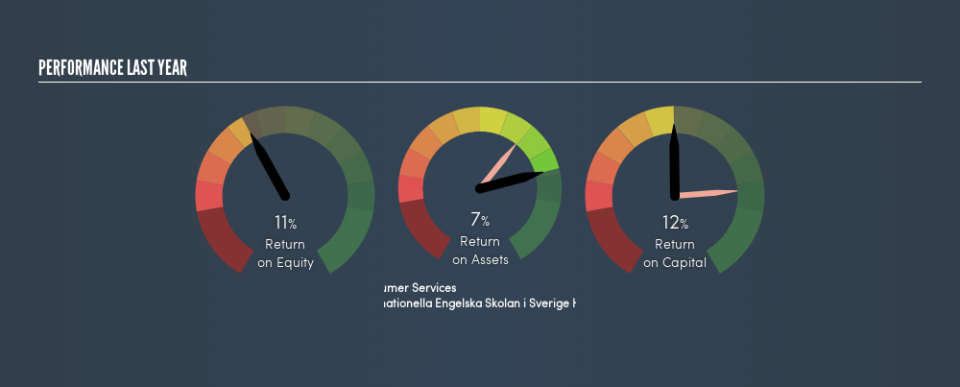Internationella Engelska Skolan i Sverige Holdings II AB (publ) (STO:ENG) Is Employing Capital Very Effectively

Today we’ll look at Internationella Engelska Skolan i Sverige Holdings II AB (publ) (STO:ENG) and reflect on its potential as an investment. To be precise, we’ll consider its Return On Capital Employed (ROCE), as that will inform our view of the quality of the business.
Firstly, we’ll go over how we calculate ROCE. Second, we’ll look at its ROCE compared to similar companies. Then we’ll determine how its current liabilities are affecting its ROCE.
What is Return On Capital Employed (ROCE)?
ROCE measures the amount of pre-tax profits a company can generate from the capital employed in its business. Generally speaking a higher ROCE is better. Ultimately, it is a useful but imperfect metric. Renowned investment researcher Michael Mauboussin has suggested that a high ROCE can indicate that ‘one dollar invested in the company generates value of more than one dollar’.
How Do You Calculate Return On Capital Employed?
The formula for calculating the return on capital employed is:
Return on Capital Employed = Earnings Before Interest and Tax (EBIT) ÷ (Total Assets – Current Liabilities)
Or for Internationella Engelska Skolan i Sverige Holdings II:
0.12 = kr153m ÷ (kr1.7b – kr399m) (Based on the trailing twelve months to December 2018.)
So, Internationella Engelska Skolan i Sverige Holdings II has an ROCE of 12%.
Check out our latest analysis for Internationella Engelska Skolan i Sverige Holdings II
Does Internationella Engelska Skolan i Sverige Holdings II Have A Good ROCE?
ROCE can be useful when making comparisons, such as between similar companies. In our analysis, Internationella Engelska Skolan i Sverige Holdings II’s ROCE is meaningfully higher than the 9.1% average in the Consumer Services industry. I think that’s good to see, since it implies the company is better than other companies at making the most of its capital. Separate from Internationella Engelska Skolan i Sverige Holdings II’s performance relative to its industry, its ROCE in absolute terms looks satisfactory, and it may be worth researching in more depth.
Internationella Engelska Skolan i Sverige Holdings II’s current ROCE of 12% is lower than its ROCE in the past, which was 22%, 3 years ago. This makes us wonder if the business is facing new challenges.
It is important to remember that ROCE shows past performance, and is not necessarily predictive. ROCE can be misleading for companies in cyclical industries, with returns looking impressive during the boom times, but very weak during the busts. ROCE is, after all, simply a snap shot of a single year. Future performance is what matters, and you can see analyst predictions in our free report on analyst forecasts for the company.
What Are Current Liabilities, And How Do They Affect Internationella Engelska Skolan i Sverige Holdings II’s ROCE?
Current liabilities include invoices, such as supplier payments, short-term debt, or a tax bill, that need to be paid within 12 months. Due to the way the ROCE equation works, having large bills due in the near term can make it look as though a company has less capital employed, and thus a higher ROCE than usual. To counteract this, we check if a company has high current liabilities, relative to its total assets.
Internationella Engelska Skolan i Sverige Holdings II has total assets of kr1.7b and current liabilities of kr399m. Therefore its current liabilities are equivalent to approximately 24% of its total assets. Current liabilities are minimal, limiting the impact on ROCE.
The Bottom Line On Internationella Engelska Skolan i Sverige Holdings II’s ROCE
With that in mind, Internationella Engelska Skolan i Sverige Holdings II’s ROCE appears pretty good. You might be able to find a better buy than Internationella Engelska Skolan i Sverige Holdings II. If you want a selection of possible winners, check out this free list of interesting companies that trade on a P/E below 20 (but have proven they can grow earnings).
If you like to buy stocks alongside management, then you might just love this free list of companies. (Hint: insiders have been buying them).
We aim to bring you long-term focused research analysis driven by fundamental data. Note that our analysis may not factor in the latest price-sensitive company announcements or qualitative material.
If you spot an error that warrants correction, please contact the editor at editorial-team@simplywallst.com. This article by Simply Wall St is general in nature. It does not constitute a recommendation to buy or sell any stock, and does not take account of your objectives, or your financial situation. Simply Wall St has no position in the stocks mentioned. Thank you for reading.

